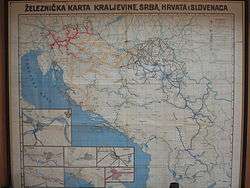Yugoslav Railways
 | |
| Government-owned | |
| Industry | Rail Transport |
| Founded | 1918 |
| Headquarters | Belgrade, SFR Yugoslavia |
| Products | Rail transport, rail infrastructure |
Yugoslav Railways (Croatian: Jugoslavenske željeznice; Macedonian: Југословенски железници, Jugoslovenski železnici; Serbian: Југословенске железнице, Jugoslovenske železnice; Slovene: Jugoslovanske železnice), with standard acronym JŽ (ЈЖ in Cyrillic), was the state railway company of Yugoslavia, operational from the 1920s to the 1990s.
History

The company was first founded as the National Railways of the Kingdom of the Serbs, Croats and Slovenes by incorporating the already existing railroad companies. In 1929, it was renamed along with the country to Yugoslav State Railways (JDŽ). In 1941 the railway ceased to exist and two new railway companies were created: Croatian State Railways (HDŽ) and Serbian State Railways (SDŽ). The railway was reestablished after World War II. In 1952 it was renamed to Yugoslav Railways.
It ceased to exist after the breakup of Yugoslavia in the 1990s. Several successor companies were formed from the assets of the railway:
- Željeznica Crne Gore (ŽCG) - Montenegro
- Hrvatske željeznice (HŽ) - Croatia
- Željeznice Federacije Bosne i Hercegovine (ŽFBiH) - Federation of Bosnia and Herzegovina, Bosnia and Herzegovina
- Željeznice Republike Srpske (ŽRS) - Republika Srpska, Bosnia and Herzegovina
- Makedonski Železnici (MŽ) - Macedonia
- Slovenske železnice (SŽ) Slovenia
- Železnice Srbije (ŽS) - Serbia
- Hekurudhat e Kosovës - Kosovo
Rolling stock
In its beginnings, the JŽ was using mostly Austrian and Hungarian-made steam locomotives. Electric and diesel locomotives were introduced in number from the 1960s onwards; electric locomotives were acquired from Ansaldo (Italy); Alsthom, ASEA also supplied some classes, and locomotives were also license built in Croatia and at Electroputere in Romania; in the 1980s the indigenous AC electric JŽ series 442 was developed by Rade Koncar.[1]
Most of the mainline diesel locomotives were from GM-EMD with a substantial number of Brissonneau et Lotz designs (some license built by Đuro Đaković). Shunters were acquired from MAVAG, and Jenbacher werke, and also license built by Đuro Đaković. The railway also operated locomotives from the Lyudinov works, Russia, ex-DB V60 shunters (Germany) and high power Krauss-Maffei ML 2200 C'C' type.[1]
Railcars, EMUs, and DMUs were sourced from Spain, Italy, Hungary and Germany from a variety of manufacturers.[1]
Classification system
A new numbering system was tried for the new standard locomotives built from 1930. All locomotives were renumbered by 1935, which was valid for steam engines.
The locomotives on the 760 mm (2 ft 5 15⁄16 in) Bosnian gauge were classified 70-98 and for the 600 mm (1 ft 11 5⁄8 in) gauge 99.2, 99.3 and 99.4.[2]
A three plus three digit class designation system was used from the late 1950s - the first digit indicated the power type of vehicle: 3 indicated a 3 kV DC locomotive; 4, a 25 kV AC loco; 6 diesel electric; 7 diesel hydraulic; 8 diesel mechanical and 9 an infrastructure or works vehicle. The second digit indicated the vehicles gauge and axle arrangement: 0, a narrow gauge railcar; 1, a standard gauge railcar; numbers 2 to 6 indicated a locomotive with that number of driving axles. The third digit indicated different classes within the type description. The fourth digit indicated class subtypes, and the last two digits the vehicle number (starting at 01).[1]
Locomotives and railcar classes
References
External links
| Wikimedia Commons has media related to Jugoslovenske železnice. |
- Frank Válóczy (ed.), Railways of the former Yugoslavia, archived from the original on 26 October 2009
- Winchester, Clarence, ed. (1936), "In central Europe", Railway Wonders of the World, pp. 1454–1463 illustrated description of the railways of Yugoslavia in the 1930s.